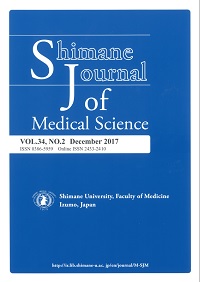Shimane University Faculty of Medicine
ISSN :0386-5959(in print)
ISSN :2433-2410(online)


These article are licensed under a Creative Commons Attribution-NonCommercial-NoDerivatives 4.0 International License.
number of downloads : ?
Use this link to cite this item : https://ir.lib.shimane-u.ac.jp/54356
Shimane Journal of Medical Science 39 1
2022-03 発行
The Prognostic Impact of Echocardiographic Indices in Patients with Severe Aortic Stenosis Who Underwent Transcatheter Aortic Valve Implantation
SHAMIM, Towfiq A.
YASUDA, Yu
KAWAHARA, Hiroshi
SATO, Hirotomo
Description
Objectives: The aim of this study was to evaluate the prognostic impact of echocardiographic indices in our real-world patients with symptomatic severe aortic stenosis (AS) patients who underwent transcatheter aortic valve implantation (TAVI).
Methods: We retrospectively reviewed the data of 54 patients with severe AS who underwent TAVI between September 2018 and May 2020. The presence and extent of cardiac damage was evaluated on baseline transthoracic echocardiography.
Results: The mean age of the cohort was 87 ± 4 years with 19 (35%) men included. With regard to cardiac damage, 3 patients (5.5%) were classified under Stage 1 (LV damage), 41 (75.9%) under Stage 2 (mitral valve or LA damage), 9 (16.6%) under Stage 3 (tricuspid or pulmonary artery vasculature damage), and 1 (1.9%) under Stage 4 (RV damage). The cumulative all cause and cardiovascular mortalities were 5.5% (n = 3) and 0%, respectively. Three patients experienced valve-related events (VRE, hospitalization for congestive heart failure) within the follow-up period, of whom 1 patient each was categorized under stages 2, 3, and 4. No significant relationship between VRE and the stage of cardiac damage was found. The relative wall thickness (RWT) of patients with VRE was significantly greater than those without VRE (0.71 ± 0.05 vs. 0.60 ± 0.08, P < 0.016). A RWT cut-off value of 0.66 (sensitivity, 100%; specificity of 72%) was obtained to detect the presence of VRE. Conclusions: Patients with smaller LV size and concentric hypertrophy are at high risk for heart failure hospitalization after TAVI.
Methods: We retrospectively reviewed the data of 54 patients with severe AS who underwent TAVI between September 2018 and May 2020. The presence and extent of cardiac damage was evaluated on baseline transthoracic echocardiography.
Results: The mean age of the cohort was 87 ± 4 years with 19 (35%) men included. With regard to cardiac damage, 3 patients (5.5%) were classified under Stage 1 (LV damage), 41 (75.9%) under Stage 2 (mitral valve or LA damage), 9 (16.6%) under Stage 3 (tricuspid or pulmonary artery vasculature damage), and 1 (1.9%) under Stage 4 (RV damage). The cumulative all cause and cardiovascular mortalities were 5.5% (n = 3) and 0%, respectively. Three patients experienced valve-related events (VRE, hospitalization for congestive heart failure) within the follow-up period, of whom 1 patient each was categorized under stages 2, 3, and 4. No significant relationship between VRE and the stage of cardiac damage was found. The relative wall thickness (RWT) of patients with VRE was significantly greater than those without VRE (0.71 ± 0.05 vs. 0.60 ± 0.08, P < 0.016). A RWT cut-off value of 0.66 (sensitivity, 100%; specificity of 72%) was obtained to detect the presence of VRE. Conclusions: Patients with smaller LV size and concentric hypertrophy are at high risk for heart failure hospitalization after TAVI.
About This Article
DOI
NCID
AA00841586
rights(link)

This article is licensed under a Creative Commons Attribution-NonCommercial-NoDerivatives 4.0 International License.
Other Article
PP. 33 - 39
